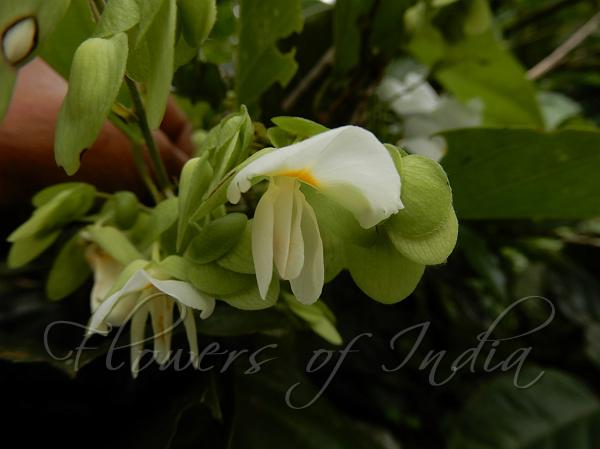|
| East-Himalayan Dalhousiea |
|

|

| File size | 242246 |
| Original date | 5/31/19 11:55 AM |
| Resolution | 5184 x 3888 |
| Flash | Flash did not fire, auto |
| Focal length | 4.3mm |
| Exposure time | 1/200s |
| Aperture | 3.4 |
| Focus Distance | |
| Metering Mode | Center weighted average |
| Camera make | NIKON |
| Camera model | COOLPIX A900 |
| Sensor type |
|
|
|
|
Photo: |
Botanical name: Dalhousiea bracteata Family: Fabaceae (Pea family)
Synonyms: Dalhousiea paucisperma, Podalyria bracteata
Synonyms: Dalhousiea paucisperma, Podalyria bracteata
East-Himalayan Dalhousiea is a climbing shrub with
round, gray-woolly, becoming hairless, branches. Leaf-stalks are
2.5-7.5 cm, leaves simple, somewhat leathery, hairless, oblong pointed,
10-30 cm long. Flowers are borne in ample at branch-end panicles with
few-flowered, nearly corymb-like branches reaching down among the
leaves. Bracts are large round, channeled. Bracteoles are similar, but
larger, completely hiding the flowers. Calyx is silky. Flowers are
snow-white, much longer than the calyx. Pods are rigidly leathery,
hairless, 5-1-0 cm long. East-Himalayan Dalhousiea is found in Eastern
Himalaya, Bangladesh and Myanmar. Flowering: May-June.
Medicinal uses: Leaves paste applied on fresh
cuts. Ritual, ceremonial, piece of bark used for divination, to
determine the cause of diseases.
Leaves paste applied on fresh
cuts. Ritual, ceremonial, piece of bark used for divination, to
determine the cause of diseases.
Medicinal uses:
 Leaves paste applied on fresh
cuts. Ritual, ceremonial, piece of bark used for divination, to
determine the cause of diseases.
Leaves paste applied on fresh
cuts. Ritual, ceremonial, piece of bark used for divination, to
determine the cause of diseases. | Identification credit: Saroj Kasaju, Paradesi Anjaneyulu | Photographed in Pasighat, Arunachal Pradesh |
• Is this flower misidentified? If yes,